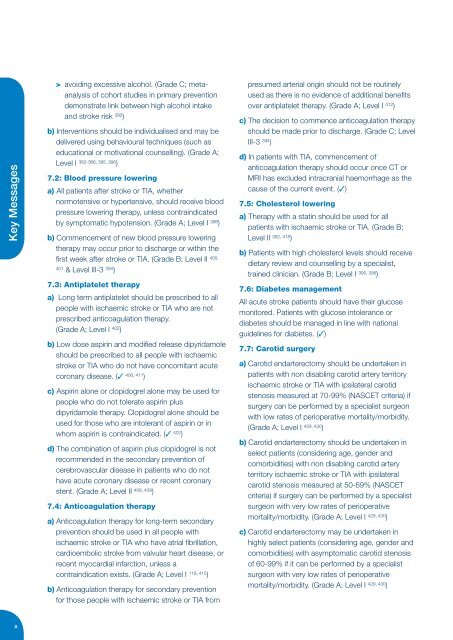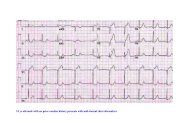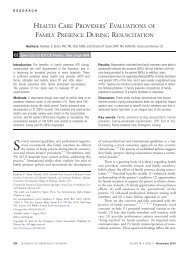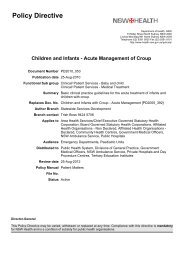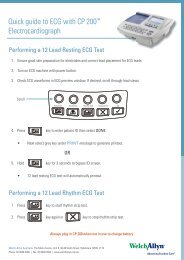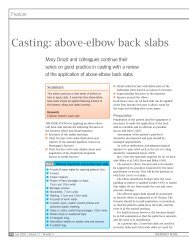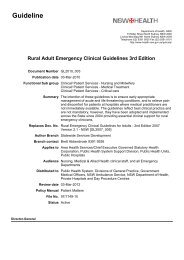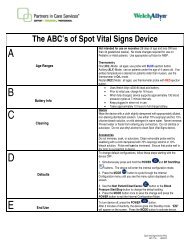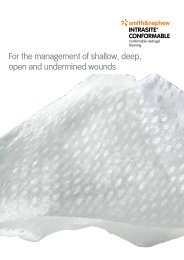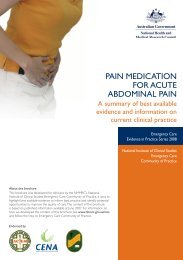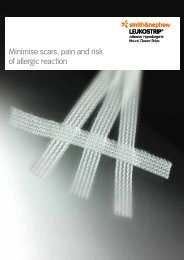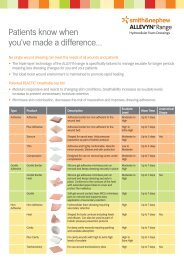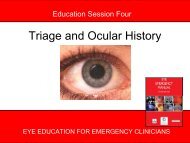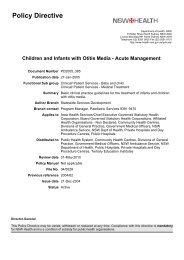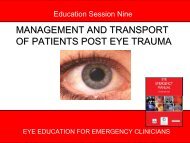Clinical Guidelines for Acute Stroke Management - Living on the EDge
Clinical Guidelines for Acute Stroke Management - Living on the EDge
Clinical Guidelines for Acute Stroke Management - Living on the EDge
You also want an ePaper? Increase the reach of your titles
YUMPU automatically turns print PDFs into web optimized ePapers that Google loves.
xKey Messages<br />
> avoiding excessive alcohol. (Grade C; metaanalysis<br />
of cohort studies in primary preventi<strong>on</strong><br />
dem<strong>on</strong>strate link between high alcohol intake<br />
and stroke risk 392 )<br />
b) Interventi<strong>on</strong>s should be individualised and may be<br />
delivered using behavioural techniques (such as<br />
educati<strong>on</strong>al or motivati<strong>on</strong>al counselling). (Grade A;<br />
Level I 362-366, 395, 396 )<br />
7.2: Blood pressure lowering<br />
a) All patients after stroke or TIA, whe<strong>the</strong>r<br />
normotensive or hypertensive, should receive blood<br />
pressure lowering <strong>the</strong>rapy, unless c<strong>on</strong>traindicated<br />
by symptomatic hypotensi<strong>on</strong>. (Grade A; Level I 398 )<br />
b) Commencement of new blood pressure lowering<br />
<strong>the</strong>rapy may occur prior to discharge or within <strong>the</strong><br />
first week after stroke or TIA. (Grade B; Level II 400,<br />
401<br />
& Level III-3 394 )<br />
7.3: Antiplatelet <strong>the</strong>rapy<br />
a) L<strong>on</strong>g term antiplatelet should be prescribed to all<br />
people with ischaemic stroke or TIA who are not<br />
prescribed anticoagulati<strong>on</strong> <strong>the</strong>rapy.<br />
(Grade A; Level I 402 )<br />
b) Low dose aspirin and modified release dipyridamole<br />
should be prescribed to all people with ischaemic<br />
stroke or TIA who do not have c<strong>on</strong>comitant acute<br />
cor<strong>on</strong>ary disease. (✓ 406, 411 )<br />
c) Aspirin al<strong>on</strong>e or clopidogrel al<strong>on</strong>e may be used <str<strong>on</strong>g>for</str<strong>on</strong>g><br />
people who do not tolerate aspirin plus<br />
dipyridamole <strong>the</strong>rapy. Clopidogrel al<strong>on</strong>e should be<br />
used <str<strong>on</strong>g>for</str<strong>on</strong>g> those who are intolerant of aspirin or in<br />
whom aspirin is c<strong>on</strong>traindicated. (✓ 402 )<br />
d) The combinati<strong>on</strong> of aspirin plus clopidogrel is not<br />
recommended in <strong>the</strong> sec<strong>on</strong>dary preventi<strong>on</strong> of<br />
cerebrovascular disease in patients who do not<br />
have acute cor<strong>on</strong>ary disease or recent cor<strong>on</strong>ary<br />
stent. (Grade A; Level II 408, 409 )<br />
7.4: Anticoagulati<strong>on</strong> <strong>the</strong>rapy<br />
a) Anticoagulati<strong>on</strong> <strong>the</strong>rapy <str<strong>on</strong>g>for</str<strong>on</strong>g> l<strong>on</strong>g-term sec<strong>on</strong>dary<br />
preventi<strong>on</strong> should be used in all people with<br />
ischaemic stroke or TIA who have atrial fibrillati<strong>on</strong>,<br />
cardioembolic stroke from valvular heart disease, or<br />
recent myocardial infarcti<strong>on</strong>, unless a<br />
c<strong>on</strong>traindicati<strong>on</strong> exists. (Grade A; Level I 119, 415 )<br />
b) Anticoagulati<strong>on</strong> <strong>the</strong>rapy <str<strong>on</strong>g>for</str<strong>on</strong>g> sec<strong>on</strong>dary preventi<strong>on</strong><br />
<str<strong>on</strong>g>for</str<strong>on</strong>g> those people with ischaemic stroke or TIA from<br />
presumed arterial origin should not be routinely<br />
used as <strong>the</strong>re is no evidence of additi<strong>on</strong>al benefits<br />
over antiplatelet <strong>the</strong>rapy. (Grade A; Level I 412 )<br />
c) The decisi<strong>on</strong> to commence anticoagulati<strong>on</strong> <strong>the</strong>rapy<br />
should be made prior to discharge. (Grade C; Level<br />
III-3 394 )<br />
d) In patients with TIA, commencement of<br />
anticoagulati<strong>on</strong> <strong>the</strong>rapy should occur <strong>on</strong>ce CT or<br />
MRI has excluded intracranial haemorrhage as <strong>the</strong><br />
cause of <strong>the</strong> current event. (✓)<br />
7.5: Cholesterol lowering<br />
a) Therapy with a statin should be used <str<strong>on</strong>g>for</str<strong>on</strong>g> all<br />
patients with ischaemic stroke or TIA. (Grade B;<br />
Level II 382, 418 )<br />
b) Patients with high cholesterol levels should receive<br />
dietary review and counselling by a specialist,<br />
trained clinician. (Grade B; Level I 395, 396 )<br />
7.6: Diabetes management<br />
All acute stroke patients should have <strong>the</strong>ir glucose<br />
m<strong>on</strong>itored. Patients with glucose intolerance or<br />
diabetes should be managed in line with nati<strong>on</strong>al<br />
guidelines <str<strong>on</strong>g>for</str<strong>on</strong>g> diabetes. (✓)<br />
7.7: Carotid surgery<br />
a) Carotid endarterectomy should be undertaken in<br />
patients with n<strong>on</strong> disabling carotid artery territory<br />
ischaemic stroke or TIA with ipsilateral carotid<br />
stenosis measured at 70-99% (NASCET criteria) if<br />
surgery can be per<str<strong>on</strong>g>for</str<strong>on</strong>g>med by a specialist surge<strong>on</strong><br />
with low rates of perioperative mortality/morbidity.<br />
(Grade A; Level I 429, 430 )<br />
b) Carotid endarterectomy should be undertaken in<br />
select patients (c<strong>on</strong>sidering age, gender and<br />
comorbidities) with n<strong>on</strong> disabling carotid artery<br />
territory ischaemic stroke or TIA with ipsilateral<br />
carotid stenosis measured at 50-69% (NASCET<br />
criteria) if surgery can be per<str<strong>on</strong>g>for</str<strong>on</strong>g>med by a specialist<br />
surge<strong>on</strong> with very low rates of perioperative<br />
mortality/morbidity. (Grade A; Level I 429, 430 )<br />
c) Carotid endarterectomy may be undertaken in<br />
highly select patients (c<strong>on</strong>sidering age, gender and<br />
comorbidities) with asymptomatic carotid stenosis<br />
of 60-99% if it can be per<str<strong>on</strong>g>for</str<strong>on</strong>g>med by a specialist<br />
surge<strong>on</strong> with very low rates of perioperative<br />
mortality/morbidity. (Grade A; Level I 429, 430 )


